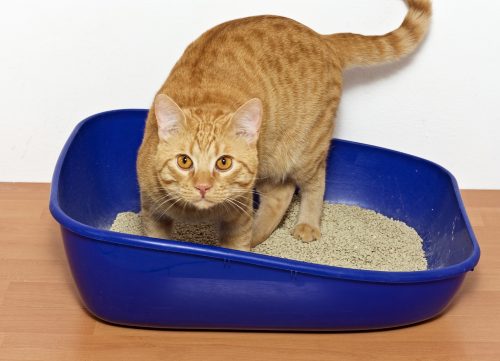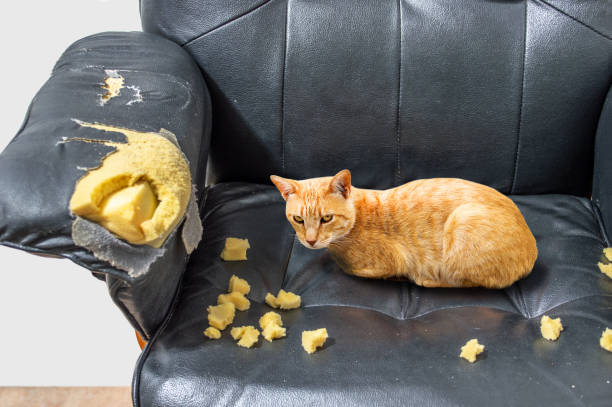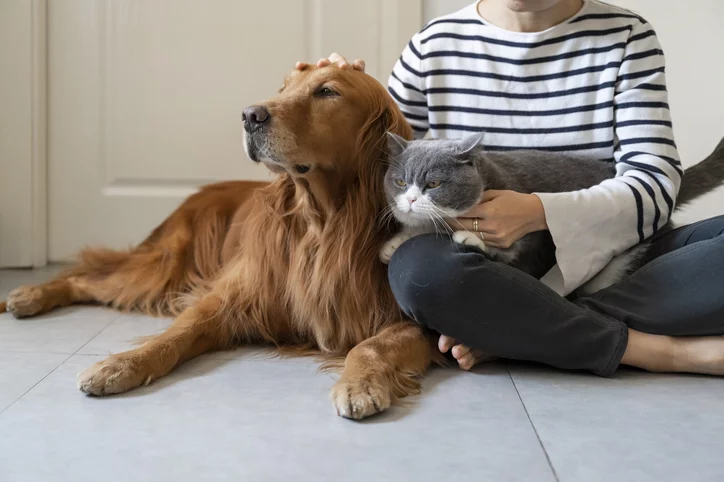Discover effective tips for dealing with cat behavior problems. This comprehensive guide offers insights and solutions to help you address common cat behavior issues. Find practical advice, expert tips, and proven techniques to create a harmonious environment for you and your feline companion.
Table of Contents
Understanding Cat Behavior
Cat Behavior Problems, Before we dive into the solutions, it is essential to comprehend the nature of our feline friends and the common behavior problems they may exhibit. Cats are unique creatures, known for their independence, curiosity, and territorial nature. However, they can also display problematic behaviors that may disrupt the peace in your home.
Identifying the root causes behind these behaviors is crucial to finding effective solutions. Each cat is an individual with its personality and preferences. By understanding their instincts and needs, we can address the underlying causes of their behavior problems.

Tips for Addressing Cat Behavior Problems
- Establish a Routine: Cats thrive on routine and consistency. Set a regular schedule for feeding, playtime, and litter box maintenance. This predictability helps them feel secure and reduces stress.
- Provide Enrichment Activities: Engage your cat in stimulating activities to keep their minds and bodies active. Interactive toys, puzzle feeders, and scratching posts can provide mental and physical stimulation.
- Ensure Proper Socialization: Introduce your cat to various people, animals, and environments from an early age. This exposure helps them develop social skills and reduces the likelihood of fear or aggression towards unfamiliar situations.
- Use Positive Reinforcement: Reward your cat’s good behavior with treats, praise, and affection. Positive reinforcement encourages desired behaviors and strengthens the bond between you and your cat.
- Seek Professional Help When Needed: If your cat’s behavior problems persist or escalate, consult a veterinarian or animal behaviorist. These professionals can provide expert guidance and tailor solutions to your cat’s specific needs.
Dealing with Aggression
- Cat Behavior Problems, Types of Aggressive Behavior: Cats may display aggression due to fear, territoriality, or redirected aggression. Identifying the type of aggression helps in devising appropriate strategies for managing it.
- Tips for Managing Aggression: Create a calm and safe environment for your cat. Provide hiding spots, separate conflicting cats, and avoid punishment. Consult a professional to develop a behavior modification plan.
Solving Litter Box Issues
- Understanding Litter Box Preferences: Cats have individual preferences for litter type, box size, and location. Experiment with different options to find the one that suits your cat’s preferences.
- Addressing Litter Box Problems: Ensure cleanliness by scooping the litter box daily and replacing the litter regularly. If your cat refuses to use the litter box, consult a veterinarian to rule out any medical conditions.

Managing Scratching and Furniture Damage
- Understanding Scratching Behavior: Scratching is a natural behavior that helps cats stretch, mark their territory, and maintain healthy claws. Provide appropriate scratching surfaces and discourage scratching on furniture using deterrents.
- Redirecting Scratching Behavior: Encourage your cat to use designated scratching posts or boards by placing them near their favorite furniture. Reward them for using the appropriate surfaces and use deterrents to protect furniture.

Handling Excessive Meowing
- Understanding the Causes of Excessive Meowing: Cats may meow excessively due to hunger, boredom, loneliness, or medical issues. Identifying the underlying cause is crucial in addressing this behavior.
- Tips for Reducing Excessive Meowing: Ensure your cat’s needs are met by providing regular meals, interactive play sessions, and companionship. If excessive meowing persists, consult a veterinarian to rule out any underlying health concerns.Click Here: Meow Mania: All Things Cats Unleashed
Coping with Anxiety and Stress
- Cat Behavior Problems, Identifying Signs of Anxiety and Stress in Cats: Cats may exhibit signs of anxiety and stress through changes in behavior, appetite, or grooming habits. Recognizing these signs is the first step in addressing their emotional well-being.
- Techniques to Reduce Anxiety and Stress: Create a calm and secure environment for your cat. Provide hiding spots, vertical spaces, and pheromone diffusers. Establish a routine and use calming techniques such as gentle massages or music specifically designed for cats.
Dealing with Introducing New Pets
- Preparing for a New Pet: Before introducing a new pet to your cat, ensure they have their private space with essential resources. Gradually introduce their scent through bedding or toys to familiarize your cat with the new arrival.
- Introducing the New Pet to Your Cat: Use a gradual and supervised introduction process. Allow them to sniff each other under a door or through a gate. Gradually increase their exposure while monitoring their behavior for signs of stress or aggression.

Click Here: For More Cat info
Conclusion
Cat Behavior Problems, In conclusion, dealing with cat behavior problems requires patience, understanding, and a tailored approach. By following the tips and techniques outlined in this guide, you can create a harmonious environment for you and your beloved feline companion. Remember, seeking professional help when needed is essential, as each cat is unique and may require individualized solutions.
FAQs
- How can I stop my cat from scratching furniture?
To prevent your cat from scratching furniture, you can take several steps:
- Provide appropriate scratching surfaces: Offer your cat a variety of scratching posts or boards made of different materials, such as sisal or cardboard. Place these surfaces near the furniture they tend to scratch.
- Use deterrents: Apply double-sided tape, aluminum foil, or sticky mats to the furniture to make it unappealing for scratching. You can also use scent deterrents or citrus sprays.
- Trim your cat’s nails: Regularly trim your cat’s nails to reduce the damage they can cause while scratching.
- Provide alternatives: Engage your cat in interactive play sessions to redirect their energy and provide them with an outlet for their natural scratching behavior.
- Reward appropriate behavior: Whenever you catch your cat using the designated scratching surfaces, praise and reward them with treats or affection.2. Why is my cat meowing excessively?
Excessive meowing in cats can have various causes, including:
- Hunger or thirst: Ensure your cat’s feeding and watering schedule is consistent and that they have access to fresh food and water.
- Attention-seeking: Cats may meow excessively to get your attention or seek interaction. Make sure to spend quality time with your cat and provide them with mental and physical stimulation.
- Stress or anxiety: Changes in the environment, such as moving or introducing new pets, can trigger excessive meowing. Create a calm and secure space for your cat and consider using pheromone diffusers or calming techniques.
- Medical issues: Excessive meowing can be a sign of an underlying health problem. If the behavior persists or is accompanied by other concerning symptoms, consult a veterinarian for a thorough examination.3. How can I introduce a new pet to my cat?
Introducing a new pet to your cat requires a gradual and supervised approach. Here are some steps to follow:
- Create separate spaces: Provide a separate space for each pet with their essential resources, including food, water, litter boxes, and resting areas.
- Exchange scents: Swap bedding or toys between the pets to familiarize them with each other’s scent before the physical introduction.
- Gradual exposure: Allow the pets to see each other through a door or gate, keeping them separated but enabling them to sniff and observe one another.
- Controlled meetings: Gradually increase their exposure to each other under close supervision. Use short and positive interactions, rewarding calm behavior with treats and praise.
- Monitor behavior: Watch for signs of stress, aggression, or fear from either pet during the introduction process. If necessary, consult a professional animal behaviorist for guidance.4. What should I do if my cat is aggressive towards other animals?
If your cat displays aggression towards other animals, it’s essential to address the issue promptly. Here are some tips:
- Cat Behavior Problems, Identify triggers: Observe your cat’s behavior to determine the specific triggers that cause aggression. It could be fear, territoriality, or resource guarding.
- Separate conflicting animals: Keep the aggressive cat and the other animals separated to prevent further conflict and provide a safe environment for everyone.
- Gradual introductions: Reintroduce the animals using controlled and supervised meetings. Use positive reinforcement and reward calm behavior.
- Consult a professional: If the aggression persists or escalates, consult a veterinarian or an animal behaviorist for a thorough evaluation and guidance on behavior modification techniques.5. How can I help my cat adjust to a new home?
Cat Behavior Problems, Moving to a new home can be stressful for cats. Here’s how you can help them adjust:
- Prepare a safe room: Set up a quiet room with your cat’s familiar belongings, such as bedding, toys, and litter box. This will serve as a safe haven during the transition.
- Gradual exploration: Allow your cat to explore the new home gradually. Start with one room at a time, gradually expanding their access as they become more comfortable.
- Maintain routines: Stick to your cat’s established routines for feeding, playtime, and litter box maintenance to provide a sense of familiarity and stability.
- Provide hiding spots: Create hiding spots throughout the house, such as cozy beds, boxes, or cat trees, where your cat can retreat and feel secure.
- Offer reassurance: Spend quality time with your cat, offering comfort, gentle petting, and treats to help them feel secure and build a positive association with the new home.6. Why is my cat not using the litter box?
Cat Behavior Problems, There can be several reasons why a cat may not use the litter box. Consider the following:
- Cleanliness: Ensure the litter box is clean by scooping it daily and completely replacing the litter regularly.
- Litter box location: Cats prefer privacy when using the litter box. Place it in a quiet and easily accessible area, away from loud noises or high foot traffic.
- Litter box type: Cats may have preferences for the type of litter or litter box. Experiment with different options to find the one your cat prefers.
- Medical issues: Urinary tract infections or other health conditions can cause litter box aversion. If your cat consistently avoids the litter box, consult a veterinarian for a thorough examination.
- Stress or anxiety: Changes in the environment or household dynamics can lead to litter box problems. Ensure your cat has a calm and secure environment and consider using pheromone diffusers or calming techniques.
Remember, each cat is unique, and it may require patience and trial-and-error to address litter box issues effectively.




















